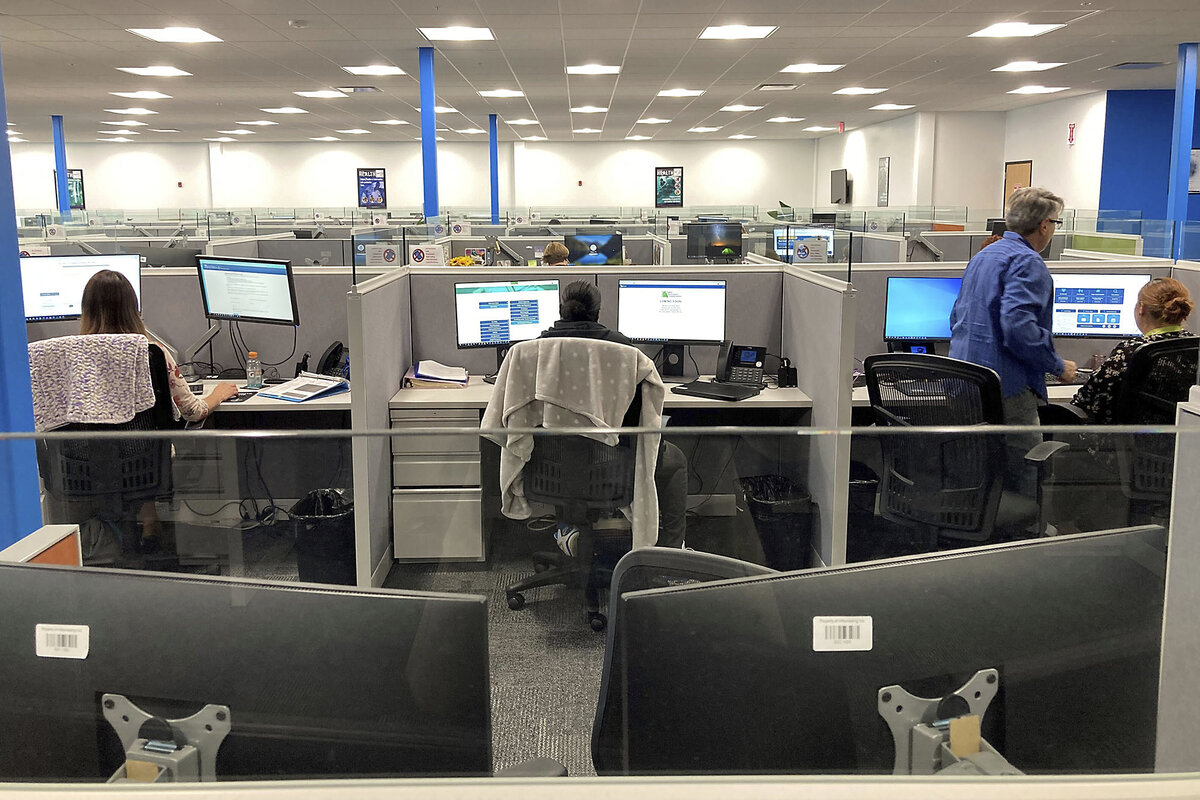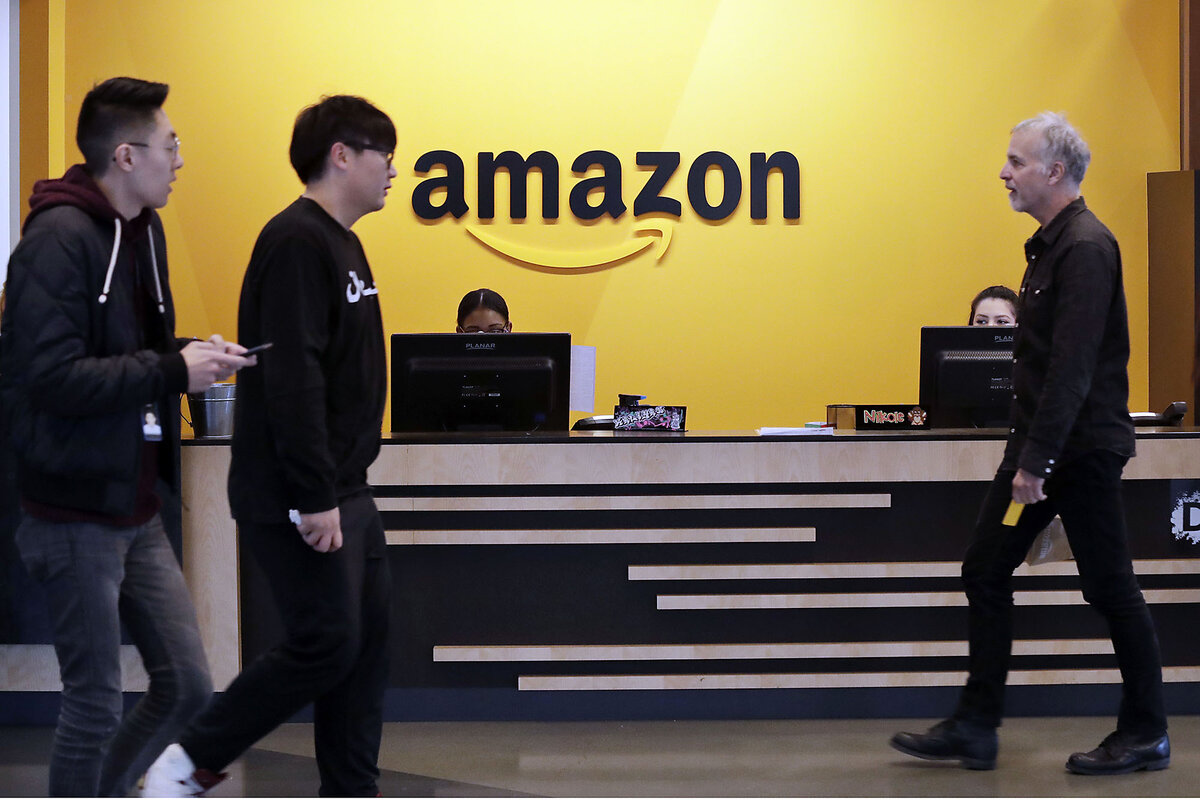AI may take away jobs – but it’s creating some, too
Loading...
The 2023 predictions were scary. Artificial intelligence would:
- Replace 300 million full-time jobs worldwide over time.
- Encroach on tasks of 2 in 5 workers.
- Drive a bigger wedge between rich people and poor people.
So far, the impact of AI on the U.S. economy has proven far more limited. Examples of massive layoffs are less frequent than some expected. Some researchers now say the technology could help low-skilled workers more than it will hurt them.
New technology always brings change and some people will lose their jobs even as new opportunities appear. But if the process unfolds over decades rather than a few years, then many employees and employers have time to adjust.
Why We Wrote This
A story focused onArtificial intelligence, while eliminating some jobs, may improve productivity and lead to better customer satisfaction. Its effect on the U.S. economy so far has proved more moderate than expected.
“Disruption is something we’ve seen over and over,” says Daniel Keum, a management professor at Columbia University. “Over time, new industries emerge. People learn how to be productive with the technology. ... But again, the bad news hits first.”
Jay Johnson, who works in advertising in Chicago, was laid off recently. His industry is pushing hard to incorporate AI chatbots, which understand and generate humanlike speech, to analyze marketing trends and generate ad copy. As the sole provider for his wife and his two young children, he’s now looking for another job.
“Challenges always exist,” he says. “It’s how we adapt and move through them.”
How companies are incorporating AI
Companies are adopting the new technology in various ways. Some emphasize efficiency.
In March, IBM disclosed a “workforce rebalancing,” reportedly in marketing and communications, that will lay off several thousand employees. Another multinational company is using AI to step up its marketing game in South America, says Dr. Keum. Instead of launching one marketing campaign per month per country, it now targets specific consumers within those countries and updates the plans weekly.
One sector feeling the heat: customer service. In February, Swedish consumer finance firm Klarna announced that AI was now handling two-thirds of its online chats with customers, doing the work of 700 full-time agents. Since the company uses contractors, Klarna didn’t have to fire anybody. It announced a hiring freeze instead. The company still relies on experienced workers to handle complex or sensitive cases, according to a spokesperson.
It’s this human-machine collaboration – rethinking and redesigning work in light of AI – that will separate winners from losers, says Erik Brynjolfsson, director of Stanford University’s Digital Economy Laboratory and co-founder of Workhelix, a consulting firm. In a research paper published last year, he and six co-authors found that the introduction of an AI assistant not only improved productivity of customer support workers at a large software firm, but also led to better customer satisfaction and reduced worker turnover.
Moreover, the technology didn’t drive a wedge between the most- and least-skilled workers; it instead helped bridge the knowledge gap, Dr. Brynjolfsson adds. AI boosted productivity for new workers and the least skilled workers by 34%, while it had negligible effects for the most skilled. By investing in retraining and work redesign, while keeping people in charge, “you can create a huge amount of value for the customers,” he says. “That is a pretty optimistic story.”
Where job losses are landing
Which story is winning out – layoffs or happier, more productive employees – is hard to discern.
Tech sector layoffs surged in 2023 as Amazon, Meta, Alphabet, and Microsoft poured billions of dollars into AI. The pace of firings has barely diminished this year with more than 75,000 employees laid off worldwide, according to Layoffs.fyi, a tracker of tech layoffs started by a Bay Area entrepreneur. While companies point to various factors, such as post-pandemic restructuring and cost-cutting, they’re increasingly hesitant to mention AI.
Why? Companies may want to avoid public backlash for replacing people with machines, said Andrew Challenger, senior vice president of Challenger, Gray & Christmas, in a company press release in March. The Chicago-based outplacement firm started tracking AI-related layoffs last year and found 3,900 in a single month. By the first quarter of this year, that total had dwindled to 383 for all three months.
Job losses are only part of the problem. Workers may find new jobs, but if those positions pay substantially less, their standard of living falls. That’s what happened to many manufacturing workers in the 1980s and 1990s, displaced by robotics and a wave of globalization. It’s happening now for a new class of well-educated workers.
Demand for skilled AI workers
Those with high-level AI skills are in strong demand from companies eager to take advantage of the technology. “We’re hiring dozens,” says Robert Murphy, chief economist for Infineo, a tech company aiming to revolutionize life insurance through AI and blockchain technology. Some companies pay the most skilled workers $900,000 or more in salary and benefits.
Three-quarters of knowledge workers say they already use AI on the job, nearly double the share of just six months ago, according to a Microsoft/LinkedIn survey of workers and employers in the United States and 30 other countries released Wednesday. “2024 is the year AI at work gets real.”
Other well-educated workers have found themselves on the wrong side of the technology.
After earning her Ph.D in art history in 2017, Allison Harbin became a researcher for academic journals. Once ChatGPT was released publicly in 2022, a fifth of her income dried up. She took a job doing “prompt engineering” – editing AI chatbots’ responses during their training. But the pay was low, and even with a new job, her income still isn’t stable.
“I’m not even going to put this on my résumé,” she says.
“Old jobs are going to be eliminated,” says Dr. Brynjolfsson of Stanford. “There’s just a lot of creative destruction and churn. [However], the tools [of AI], when used correctly, will help rebuild the middle class and will help create more widely shared prosperity.”








